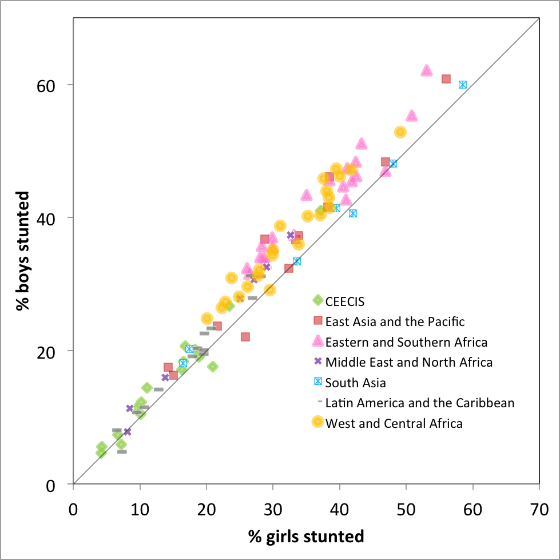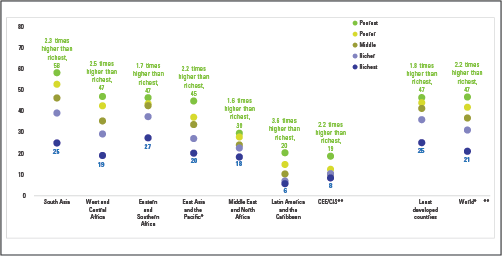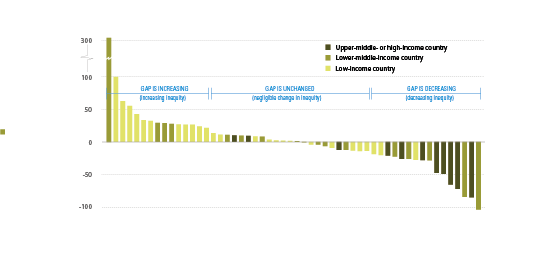Nearly half of all deaths in children under 5 are attributable to undernutrition. This translates into the unnecessary loss of about 3 million young lives a year. Undernutrition puts children at greater risk of dying from common infections, increases the frequency and severity of such infections, and contributes to delayed recovery. In addition, the interaction between undernutrition and infection can create a potentially lethal cycle of worsening illness and deteriorating nutritional status. Poor nutrition in the first 1,000 days of a child’s life can also lead to stunted growth, which is irreversible and associated with impaired cognitive ability and reduced school and work performance.

Improving Child Nutrition: The achievable imperative for global progress
This report builds on earlier findings on the impact of undernutrition by highlighting new developments and demonstrating that efforts to scale up nutrition programmes are working, benefiting children in many countries.

Child nutrition interactive dashboard: 2015 edition
The UNICEF-WHO-World Bank Group Child Malnutrition Dashboard allows users to generate a variety of graphs and charts, using the newest joint estimates for child malnutrition. Estimates of prevalence and numbers for child stunting, underweight, overweight and wasting are presented for the 1990 to 2014 period by the Agency Classifications of United Nations, Millennium Development Goal, UNICEF regions, WHO regions, World Bank income groups and World Bank regions.
Levels and Trends in Child Malnutrition: 2015 edition
In September 2015, UNICEF, WHO and World Bank Group released an updated joint dataset on child malnutrition indicators (stunting, wasting, severe wasting, overweight and underweight) and new global & regional estimates covering the 1990 to 2014 period. This summary note presents key messages and highlights refinements to the method.
INDICATORS
|
Indicator name |
Definition |
|
|---|---|---|
|
Numerator |
Denominator |
|
|
Stunting |
Number of under-fives falling below minus 2 standard deviations (moderate and severe) and minus 3 standard deviations (severe) from the median height-for-age of the reference population |
Children under 5 years of age in the surveyed population |
|
Underweight |
Number of under-fives falling below minus 2 standard deviations (moderate and severe) and minus 3 standard deviations (severe) from the median weight-for-age of the reference population |
Children under 5 years of age in the surveyed population |
|
Wasting |
Number of under-fives falling below minus 2 standard deviations (moderate and severe) and minus 3 standard deviations (severe) from the median weight-for-height of the reference population |
Children under 5 years of age in the surveyed population |
|
Overweight |
Number of under-fives above 2 standard deviations from the median weight-for-height of the reference population |
Children under 5 years of age in the surveyed population |
REFERENCE POPULATION
Prevalence of underweight, stunting and wasting among children under 5 is estimated by comparing actual measurements to an international standard reference population. In April 2006, the World Health Organization released the WHO Child Growth Standards to replace the widely used National Center for Health Statistics (NCHS)/WHO reference population, which was based on a limited sample of children from the United States of America. The new standards are the result of an intensive study project involving more than 8,000 children from Brazil, Ghana, India, Norway, Oman and the United States. Overcoming the technical and biological drawbacks of the old reference population, the new standards confirm that children born anywhere in the world and given the optimum start in life have the potential to reach the same range of height and weight. It follows that differences in children's growth to age 5 are more influenced by nutrition, feeding practices, environment and health care than by genetics or ethnicity.
The new standards should be used in future assessments of child nutritional status. It should be noted that because of the differences between the old reference population and the new standards, prevalence estimates of child anthropometry indicators based on these two references are not readily comparable. It is essential that all estimates are based on the same reference population (preferably the new standards) when conducting trend analyses.
ADJUSTING COUNTRY-LEVEL ESTIMATES
Before conducting trend analyses of child nutritional status, it is important to ensure that estimates from various data sources are comparable over time. For example, household surveys in some countries in the early 1990s only collected child anthropometry information among children up to 47 months of age – or even up to only 35 months of age. Prevalence estimates based on such data only referred to children under 4 or under 3 years of age and are not comparable to prevalence estimates based on data collected from children up to 59 months of age. Some age adjustment needs to be applied to make these estimates based on non-standard age groups comparable to those based on the standard age range. For more information about age adjustment, please click here to read a technical note. In addition, prevalence estimates need to be calculated according to the same reference population. Those calculated according to the WHO Child Growth Standards are not comparable to those calculated according to the NCHS/WHO reference population. For more information about the difference between the two references and its implications, please click here to read a technical note.
ESTIMATING COUNTRY-LEVEL PROGRESS
Country-level progress in reducing undernutrition prevalence is evaluated by calculating the average annual rate of reduction (AARR) and comparing this to the AARR needed in order to be able to reduce prevalence by half over 25 years. For more information about how to calculate country-level AARR, please click here to read a technical note.
ESTIMATING REGIONAL TRENDS BY MULTILEVEL MODELLING
Estimation of regional and global trends has been based on a multilevel modelling method (see de Onis et al. in JAMA, 2004). For the most recent trend analysis presented below, a total of 716 data points from 145 countries over the period 1985 to 2013 were included in the model. This set of trend data points was jointly reviewed by UNICEF and WHO in June and July 2014 to ensure that it is nationally representative of under-five children, processed using standard algorithms and comparable vertically and horizontally. Regional trend modelling and graphing were carried out using STATA 11 on two ‘do’ files (the data set and do files are available on request).
Model-based trend analysis of underweight prevalence (percentage), by region

Note: * CEE/CIS: Central and Eastern Europe and the Commonwealth of Independent States.
How to read this chart:
Each circle (bubble) represents a prevalence estimate from a country in a data year. The size of the circle is proportional to the under-five population in that country in the data year. For each region, a solid line indicates the regional trend as modelled by the multilevel logit regression on all the available data points in the region. The dashed lines in each region indicate the lower and upper bounds of the regional trend line corresponding to the confidence interval of the estimated trend.
Click here for a higher-resolution version of the above chart.


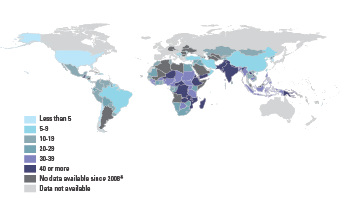


_164.png)
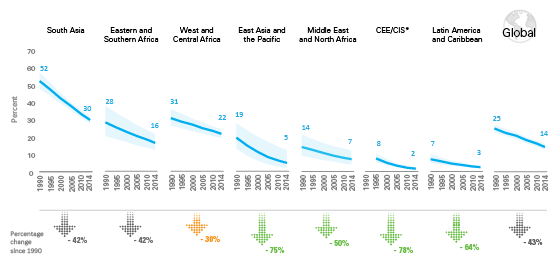
_271.png)
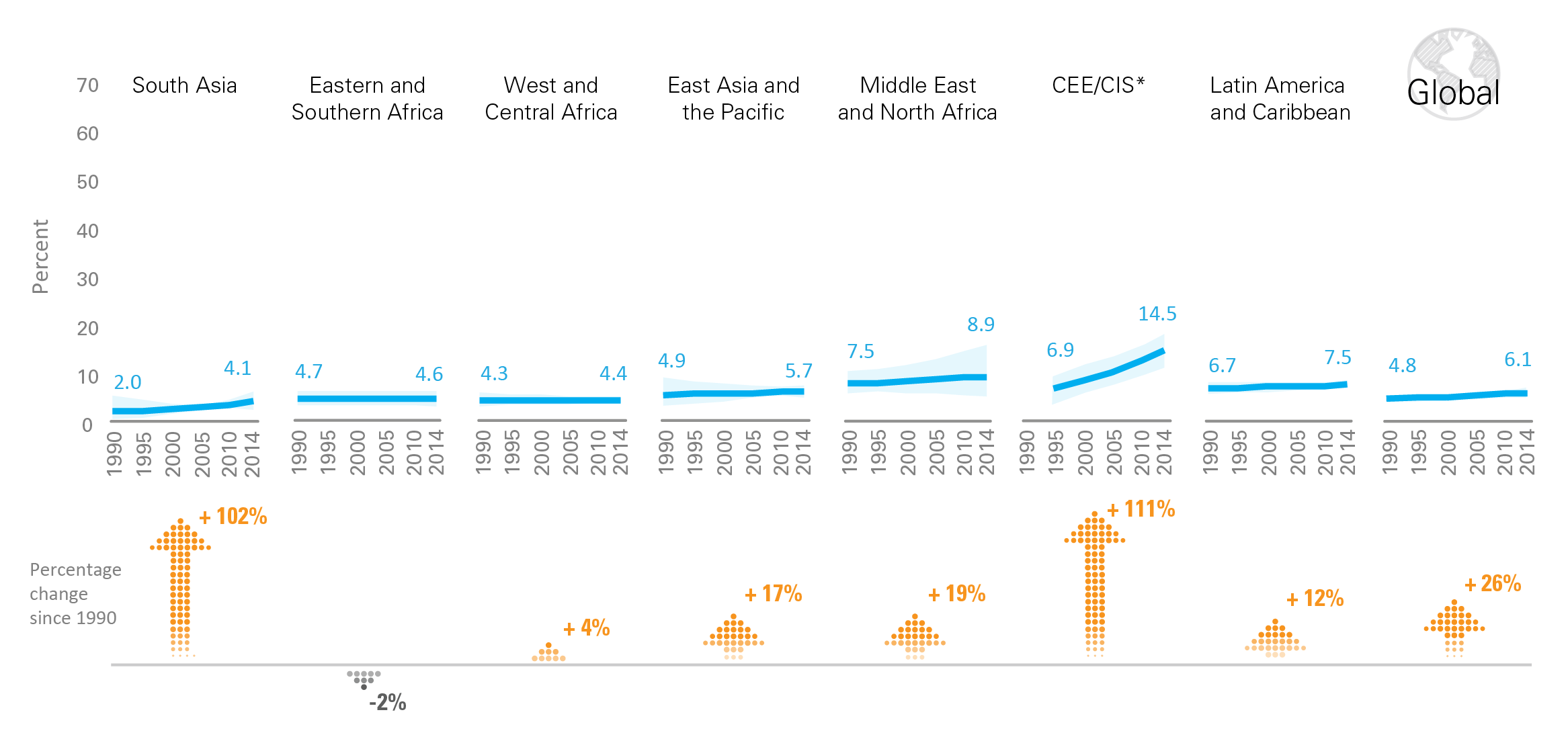
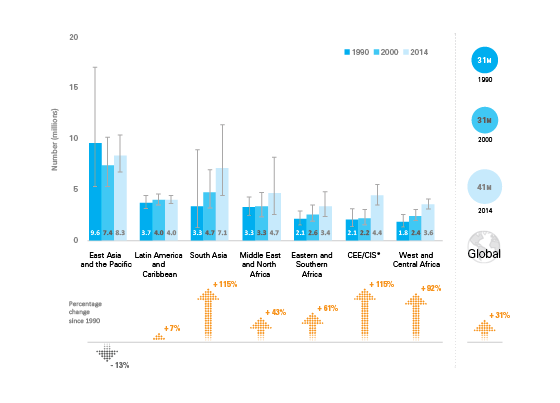
_279.png)
